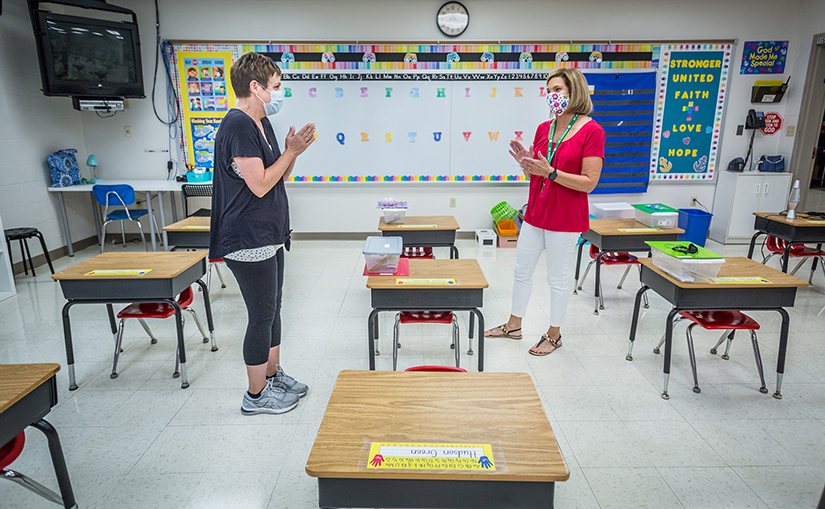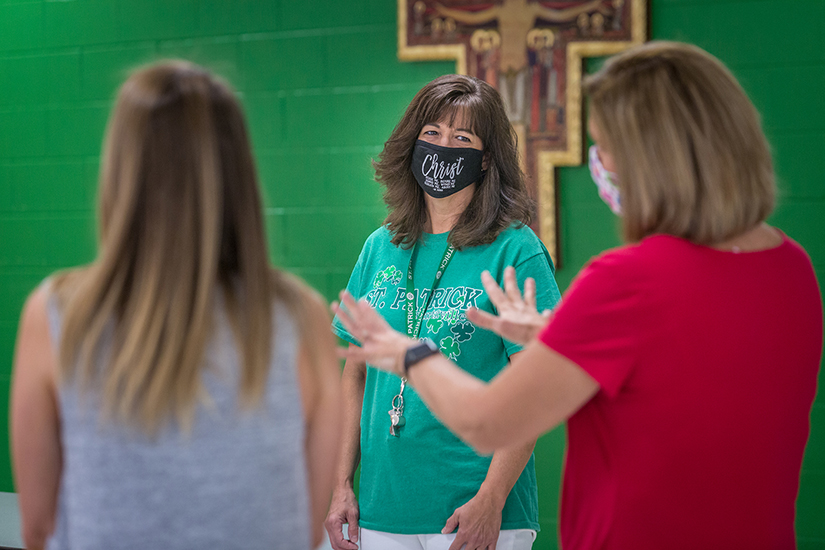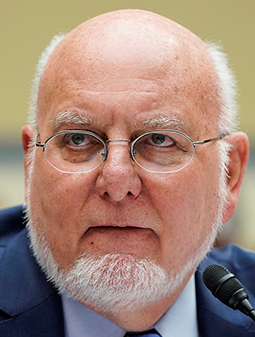 Christine McKenzie, left, a first-grade teacher at St. Patrick School in Wentzville, explained to principal Jill Gould how she spaced out the students desks as teachers prepared their classrooms Aug. 12.Photo Credits: Lisa JohnstonEveryone has a role in helping to mitigate the spread of the novel coronavirus this fall as children return to school.
Christine McKenzie, left, a first-grade teacher at St. Patrick School in Wentzville, explained to principal Jill Gould how she spaced out the students desks as teachers prepared their classrooms Aug. 12.Photo Credits: Lisa JohnstonEveryone has a role in helping to mitigate the spread of the novel coronavirus this fall as children return to school.
Dr. Rachel Orscheln, a pediatrician and member of Christ the King Parish in University City, said that strategies such as health screenings at home before going to school, wearing face coverings, good hygiene practices, improved ventilation and keeping a distance of three to six feet will help decrease the spread of the virus. She recommended that people get the influenza vaccine, in an effort to reduce the  Dr. Orschelntransmission of the flu virus, which shares similar symptoms as
COVID-19.
Dr. Orschelntransmission of the flu virus, which shares similar symptoms as
COVID-19.
“We have to prepare ourselves that this will be a new normal for some time to come,” said Orscheln, an associate professor of pediatrics in the division of infectious diseases at Washington University and St. Louis Children’s Hospital. “That’s why we need to develop effective strategies for going back to school.”
Orscheln has provided her expertise to private schools in making plans to return to school. She also has served as a consultor to the Missouri Department of Elementary and Secondary Education and other organizations such as EducationPlus, a non-profit agency that collaborates with public school districts in Missouri.
SARS-CoV-2 the novel coronavirus is similar to other respiratory viruses, which spread primarily through respiratory droplets from the mouth and nose, which are projected through actions such as coughing, sneezing, singing, and talking loudly or yelling. The droplets “typically drop to the ground within three to six feet, which is why the distance is important,” she said, as well as wearing face masks that cover the nose and mouth. “If droplets from an infectious person fall in sufficient quantity onto the eyes, nose or mouth of another person, an infection can result.”
It’s also possible that the virus could spread through other methods, such as touching a surface that has droplets on it, or in certain circumstances where the droplets remain in the air for a longer period of time. “But data on transmissions does not suggest that the novel coronavirus is primarily spread these ways,” Orscheln stressed.
In general, children typically are the main drivers of infection, such as influenza outbreaks, but the novel coronavirus is different in that children under the age of 10 appear to be infected and transmit the infection less easily, she said. However, adolescents (children over 10) may spread the virus in a way that is similar to adults. Most children who are infected with the novel coronavirus will have minor symptoms and some will have no symptoms at all. Children under the age of 19 are hospitalized at much lower rates for
COVID-19 than adults, Orscheln said. The risk of serious illness increases with age, and with other underlying health issues, she added.
There is a better understanding of how to lessen the spread of the virus now compared to when the outbreak began last spring. “Back then, we were wiping everything down and not wearing masks,” Orscheln said. “We didn’t appreciate droplet transmission as the primary method of spread. Cloth masks can reduce this, and we have seen studies with reduced rates.”
She cited a study from the Centers for Disease Control in which two hairstylists in Springfield, Missouri, interacted with nearly 150 clients and co-workers before learning they had COVID-19. Both were wearing masks, and no symptomatic secondary cases were reported. The study reported that adherence to the community’s and company’s face-covering policy likely mitigated spread of the virus.
One of the biggest risks is transmitting the virus among adults, and Orscheln cautioned adults not to let down their guard when children are not around. “We can’t put our fear into being around children and then let down our guard with just adults being around one another,” she said. “If you’re around other people there’s not a zero risk.” St. Patrick School eighth-grade teacher Chrstine Eckert, center, listened with other teachers to principal Jill Gould, right. The teachers were preparing their classrooms to conform with safety guidelines and have a faculty retreat day at the school in Wentzville Aug. 12.Photo Credits: Lisa Johnston
St. Patrick School eighth-grade teacher Chrstine Eckert, center, listened with other teachers to principal Jill Gould, right. The teachers were preparing their classrooms to conform with safety guidelines and have a faculty retreat day at the school in Wentzville Aug. 12.Photo Credits: Lisa Johnston
>> Protect yourself (and others)
The Centers for Disease Control offer guidelines for preventing the spread of the COVID-19 coronavirus. The CDC notes that the virus is thought to spread mainly from person-to-person.
• Between people who are in close contact with one another (within about 6 feet).
• Through respiratory droplets produced when an infected person coughs, sneezes or talks.
• These droplets can land in the mouths or noses of people who are nearby or possibly be inhaled into the lungs.
• Some recent studies have suggested that COVID-19 may be spread by people who are not showing symptoms.
The CDC also offers these guidelines to help mitigate the spread of the virus:
• Wash your hands often
• Avoid close contact
• Cover your mouth and nose with a mask when around others
• Cover coughs and sneezes
• Clean and disinfect
• Monitor your health daily
For more detailed information, visit www.cdc.gov/coronavirus/2019-ncov/prevent-getting-sick/prevention.html
CDC head sees need for schools to reopen but with strict health protocols
By Ian Alvano | Catholic News Service
 Dr. RedfieldWASHINGTON — Dr. Robert Redfield, director of the Centers for Disease Control and Prevention, thinks it is a good idea for schools to reopen for in-person classes but with restrictions in place to protect teachers, staff and students against the coronavirus, including “wearing a mask, washing your hands, maintaining social distancing.”
Dr. RedfieldWASHINGTON — Dr. Robert Redfield, director of the Centers for Disease Control and Prevention, thinks it is a good idea for schools to reopen for in-person classes but with restrictions in place to protect teachers, staff and students against the coronavirus, including “wearing a mask, washing your hands, maintaining social distancing.”
Reopening “has to be done safely, and it has to be done with the confidence of the teachers,” Redfield said. “It has to be done with the confidence of parents. And so I think each of the school districts will begin to wrestle with this.”
“It’s not the risk of school openings versus public health. It’s public health versus public health,” he said during a recent webinar with the Buck Institute for Aging, an independent biomedical research institute based in Novato, California.
“I weigh that equation as an individual who has 11 grandchildren, that the greater risk to the nation is actually to keep these schools closed,” said Redfield, who is a Catholic.
However, “local school districts are going to have to make these decisions,” he added.
The threat of drug overdoses and suicide proves to be “far greater” concerns than the COVID-19 pandemic for many people, particularly in high schools, according to Redfield.
“You know, a lot of kids get their mental health services, over 7 million, in school. A lot of people get food and nutrition in schools. Schools are really important in terms of mandatory reporting sexual and child abuse,” the physician explained. “Obviously, the socialization is important. And, obviously, for some kids, I think actually a majority of kids, their learning in a face-to-face school is the most effective method of teaching.”
News reports Aug. 10 said that 17 out of the nation’s 20 largest public school systems have decided to teach students only online. Other public and nonpublic schools are choosing a “hybrid” option with some in-person classes and some online classes. Some Catholic dioceses around the country have chosen to reopen their schools for in-person learning, following local health and safety protocols and CDC guidelines to protect students. teachers and staff from the coronavirus.
The CDC’s guidance is aimed at K-12 schools as well as colleges and universities, but “our guidance is not in stone. Our guidance is not meant to be impractical,” Redfield said, “and we have to work with each district as they try to translate that guidance into a functional plan.”
Its lengthy detailed guidance — which can be found online at https://bit.ly/2XODgHV — includes about a dozen recommendations ranging from encouraging everyone in the school and community to practice preventive behaviors to educating and reinforcing “appropriate hygiene and social-distancing practices” to cleaning and disinfecting frequently touched surfaces.
“This guidance is meant to supplement — not replace — any state, local, territorial, or tribal health and safety laws, rules and regulations with which schools must comply,” the CDC says.
Schools cannot get ready “faster than you’re ready to do it,” Redfield said.
“None of us is going to compromise safety,” he added about himself and other doctors who support schools reopening.